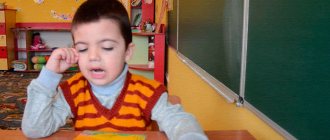Article:
General underdevelopment of speech is considered as a systemic disorder of speech activity, complex speech disorders, in which the formation of all components of the speech system, relating to both the sound and semantic aspects, is impaired in children, with normal hearing and intact intelligence (R. E. Levina, T. B. Filicheva, G.V. Chirkina).
Speech failure with general speech underdevelopment in preschool children can vary from complete absence of speech to extensive speech with pronounced manifestations of lexico-grammatical and phonetic-phonemic underdevelopment (R. E. Levin). Currently, there are four levels of speech development, reflecting the state of all components of the language system in children with general speech underdevelopment (T. B. Filicheva).
At the first level of speech development, the child’s speech means are limited, the active vocabulary is practically not formed and consists of onomatopoeia, sound complexes, and babbling words. Statements are accompanied by gestures and facial expressions. Characteristic is the polysemy of the words used, when the same babbling words are used to designate different objects and phenomena. It is possible to replace the names of objects with the names of actions and vice versa. In active speech, root words without inflections predominate. The passive vocabulary is wider than the active one, but also extremely limited. There is practically no understanding of the categories of number of nouns and verbs, tense, gender, and case. The pronunciation of sounds is diffuse. Phonemic development is in its infancy. The ability to perceive and reproduce the syllabic structure of a word is limited.
When moving to the second level of speech development, the child’s speech activity increases. Active vocabulary expands due to everyday subject and verbal vocabulary. It is possible to use pronouns, conjunctions and sometimes simple prepositions. The child’s independent statements already contain simple, uncommon sentences. At the same time, there are gross errors in the use of grammatical structures, there is no agreement between adjectives and nouns, and there is a confusion of case forms. Understanding of addressed speech is developing significantly, although the passive vocabulary is limited, the subject and verbal vocabulary associated with the work activities of adults, flora and fauna has not been formed. There is a lack of knowledge not only of color shades, but also of primary colors.
Gross violations of the syllabic structure and sound filling of words are typical. Children exhibit insufficiency in the phonetic aspect of speech (a large number of unformed sounds).
The third level of speech development is characterized by the presence of extensive phrasal speech with elements of lexico-grammatical and phonetic-phonemic underdevelopment. There are attempts to use even sentences of complex constructions. The child's vocabulary includes all parts of speech. In this case, inaccurate use of the lexical meanings of words may be observed. The first word formation skills appear. The child forms nouns and adjectives with diminutive suffixes, verbs of motion with prefixes. Difficulties are noted in forming adjectives from nouns. Multiple agrammatisms are still noted. The child may use prepositions incorrectly and make mistakes in agreeing adjectives and numerals with nouns. Undifferentiated pronunciation of sounds is characteristic, and replacements may be unstable. Pronunciation deficiencies can be expressed in distortion, replacement or mixing of sounds. The pronunciation of words with a complex syllabic structure becomes more stable. A child can repeat three- and four-syllable words after an adult, but distorts them in the speech stream. Speech understanding is approaching normal, although there is insufficient understanding of the meanings of words expressed by prefixes and suffixes.
The fourth level of speech development (T. B. Filicheva) is characterized by minor violations of the components of the child’s language system. There is insufficient differentiation of sounds [t—t'—s—s'—ts], [p—p'—l—l'—j], etc. Characteristic are peculiar violations of the syllabic structure of words, manifested in the child’s inability to retain the phonemic image of a word in memory while understanding its meaning. The consequence of this is a distortion of the sound content of words in various versions. Insufficient speech intelligibility and unclear diction leave the impression of “blurry”. Errors in the use of suffixes (singularities, emotional connotations, diminutives) remain persistent. Difficulties in forming complex words are noted. In addition, the child experiences difficulties in planning a statement and selecting appropriate linguistic means, which determines the originality of his coherent speech. Complex sentences with different subordinate clauses present particular difficulty for this category of children. L.S. Volkova notes in children with general speech underdevelopment a persistent lag in the formation of all components of the language system: phonetics, vocabulary and grammar.
Speech activity is formed and functions in close connection with the child’s psyche (L.S. Vygotsky). Children with general speech underdevelopment have, in comparison with the age norm, features of the development of sensorimotor, higher mental functions, and mental activity.
R.M. Boskis, R.E. Levina, N.A. Nikashina note that in children with OPD, not only speech suffers, but also higher mental functions associated with it (attention, perception of various modalities, visual-spatial representations, optomotor coordination, memory and thinking), and fine motor skills of the fingers are insufficiently developed.
T.B. Filicheva also notes that while semantic and logical memory is relatively preserved, children’s verbal memory and memorization productivity are reduced compared to their normally speaking peers. Some preschoolers have low recall activity, which is combined with limited opportunities for the development of cognitive activity. The connection between speech disorders and other aspects of mental development determines some specific features of thinking. Having complete prerequisites for mastering mental operations accessible to their age, children lag behind in the development of the visual-figurative sphere of thinking, without special training they have difficulty mastering analysis, synthesis, and comparison. Many of them are characterized by rigidity of thinking. Such children experience difficulties in classifying objects and generalizing phenomena and signs.
Personality problems are also common in children with general speech underdevelopment: low self-esteem, communication disorders, anxiety, aggressiveness.
According to G.V. Chirkina, children have unstable and dwindling attention, poorly formed voluntary attention. It is difficult for children to concentrate on one subject and switch to another on a special task. Peculiarities in the course of mental operations are noted: along with the predominance of visual-figurative thinking, children may find it difficult to understand abstract concepts and relationships. The speed of mental operations may be somewhat slow.
R.E. Levina, G.A. Kashe, T. A. Tkachenko, S. N. Shakhovskaya, T. B. Filicheva, G. V. Chirkina, G. A. Volkova note that with OHP, phonetic disorders are common, have a persistent nature, and are similar in their manifestations to other articulatory disorders and pose significant difficulties for differential diagnosis and correction. These disorders have a negative impact on the formation and development of the phonemic aspect of speech.
E.F. Sobotovich, A.F. Chernopolskaya, L.V. Melekhova noted in children with OHP the inaccuracy, weakness of movements of the organs of the articulatory apparatus, their rapid exhaustion, and pronunciation deficiencies were eliminated only as a result of articulatory gymnastics and the development of the correct articulatory structure of a particular sound. Automation of sounds is extremely difficult.
In pedagogical terms, preschoolers with special needs G.V. Chirkina characterizes it as follows: “children’s behavior can be unstable, with frequent mood swings. During classes, children quickly get tired; it is difficult for them to complete one task for a long time. There may be difficulties in remembering the teacher’s instructions, especially two-, three-, four-step instructions that require step-by-step and sequential implementation.” These violations have a negative impact on the formation and development of other aspects of speech (phonemic, lexical, grammatical, coherent utterance).
T.B. Filicheva, N.A. Chevelev, deviations in the emotional-volitional sphere are noted in children with OHP. Children are characterized by instability of interests, decreased observation, decreased motivation, negativism, self-doubt, increased irritability, difficulties in communicating with others, in establishing contacts with their peers, difficulties in developing self-regulation and self-control.
Characteristics of speech in OHP level I
With level I OHP, most sounds are absent. Most often, the sounds of early ontogenesis remain undisturbed. Preserved sounds are unstable in use. In speech, the leading place is occupied by short words of one or two syllables. When trying to pronounce a longer word, the child skips syllables.
Children have difficulty distinguishing even non-speech sounds that are distant in sound. Both passive and active vocabulary are sharply limited. Kids mostly communicate non-verbally; they have well-developed facial expressions, gestures, and intonation.
When communicating verbally, onomatopoeic phrases are used, their fragments, words that are not similar to any others, “lightweight, childish”, used by one of the elders in conversations. The same word can be used to denote several concepts. The preschooler does not have phrasal speech or monologue. Level I OHP is diagnosed at the age of three.
Causes of the disorder
Various reasons can lead to phonetic-phonemic brain damage. This can happen in the first years of the baby's life, during the placental period of development, or during childbirth.
Speech disorder can occur under the influence of various internal and external causes:
- neuroinfection;
- intoxication;
- birth injury;
- hereditary disorder of the central nervous system.
Speech is an important social function. For a child to grow fully, he needs communication with adults who are emotionally close to him. Unfavorable conditions in raising a child during the period of speech formation can lead to a delay in his development.
External factors influencing general speech underdevelopment:
- dysfunctional home conditions;
- lack of communication due to hearing and speech problems of relatives.
Disorders of oral speech and tempo can be caused by the following diseases:
- disorder of the vocal apparatus - dysphonia;
- frequent repetition or prolongation of sounds – stuttering;
- violation of sound pronunciation - dyslalia;
- nasality - rhinolalia;
- complete or partial loss of speech – aphasia;
- difficulty making disarticulated sounds - bradyllia;
- jerky stops for breathing - battarism;
- inability to master writing - dysgraphia;
- accelerated speech with hesitations, stumbling, and unnecessary pauses.
Often a combination of different reasons can be identified. Therefore, it is very important to establish the true factors to help the child cope with his problem. Severe violations require immediate treatment and special corrective work.
Useful and interesting facts
Ancient people spoke quite primitively, including vocal, visual and tactile functions. It was more like an exchange of information among animals. We learned to talk, when we started using symbols, we began to want to share this knowledge with our people. Scientists believe that the first symbol appeared when they began to make tools from stone. This was almost 2.5 million years ago. The activity played a leading role in the history of the development of human communication.
The first mention of speech defects associated with physical injury was in the ancient Egyptian papyrus of Edwin Smith. In religious epics, such as the Bible and the Koran, there are descriptions of miraculous healing of speech disorders. The priests gave a divine coloring to the fact of difficult speech.
Hippocrates was the first to write about the role of the brain in his writings, where he outlined his view of how the formation of human voice and speech occurs.
The speech correction process is quite lengthy and labor-intensive. The accumulated experience of specialized specialists shows that it is parents who need to pay special attention to the environment in which the baby lives. You also need to engage in speech development from a very early age.
Characteristics of speech of children with NDD
Recently, level IV ONR or NONR (mildly expressed general underdevelopment of speech) has been isolated. Preschoolers with NLD do not have serious problems with sound pronunciation, but with rapid speech, sounds are mixed or replaced. The narratives are incomprehensible, inexpressive, sluggish.
The vocabulary of such children does not differ from that of their peers without speech problems. For coherent speech, it becomes typical to “obsess over” minor details and omit the main ones, repeating certain points. The stories are not very informative. NONR is diagnosed from the age of 6 years.





